Seeing Double Masters 2022 | Magic: The Gathering
Welcome to Double Masters 2022 previews. This week, I'm going to tell you the story of the set's design and show off two preview cards.
Before I start with the story of this set, I want to remind you of how the original Double Masters worked, as this year's Double Masters follows in the footsteps of that product with a few small tweaks.
The first Double Masters had 332 cards (91 commons, 80 uncommons, 121 rares, and 40 mythic rares). Double Masters 2022 also has 332 cards, but there's a slight tweak (91 commons, 80 uncommons, 120 rares, 40 mythic rares, and 1 card that shows up in every booster), it has one less rare and one new card that's a rarity below common. That card is called Cryptic Spires, and it's a brand-new card meant to help with mana fixing. (More on why the set needs it below.)
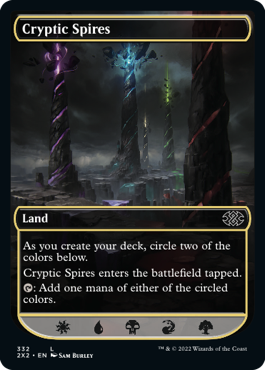
Original Double Masters came in a fifteen-card booster and every booster had two rares/mythic rares and two premium (i.e., traditional foil) cards. All of that is true for Double Masters 2022, except it comes with the sixteenth card always being Cryptic Spires. (Note that this is just for the Draft Boosters; the Collector Boosters only have fifteen cards, although they will have four rares/mythic rares.)
When you draft the product, you get to take two cards for the first pick of each booster. This allows you to take both rares, two cards that combo, two cards that are high in synergy, or just two cards you like. Every following pick out of the booster is just one card. This means you draft two cards together three times during the draft. How drafting works hasn't changed for Double Masters 2022. (For more on the design of the original Double Masters, you can read my article Double Deal.)
Double Masters 2022 isn't trying to reinvent the wheel. Original Double Masters was popular, so the new set follows the same basic formula while creating something new thematically. The big question for Bryan Hawley and his Vision Design team (Erik Lauer, Yoni Skolnik, and himself) and his Set Design team (Michelle Roberson, Rob Shuster, Reggie Valk, and himself) was to find a new theme to build around, what we call a "topline" in design. Original Double Masters had an artifact theme. What would make a cool theme for Double Masters 2022?
The key to finding the theme was having a good understanding of what Double Masters sets are about (from the context of Limited; from a Constructed standpoint, we want them to deliver a lot of cards players will get excited to open).
- They cater to highly enfranchised players.
In most sets, we spend a lot of time making sure less enfranchised players will find the set's themes and draft structure approachable. Double Masters doesn't have this issue as the key audience for it are people who are well versed in the game. This allows it to do many things that normal sets can't, which I will touch upon in the points below.
- The average power level is higher.
Being a reprint set (meaning the cards, especially at higher rarities, are skewed toward things players want for Constructed purposes), the cards tend to be from the powerful end of the spectrum. Adding that the set has more rares and mythic rares than normal showing up at twice the rate per pack, and you end up with a Limited environment that's a bit more juiced than average.
- The complexity is higher.
Enfranchised players can handle more going on in the Limited environment, so that allows the designers to ratchet up both how many themes there are in the set and how much variety exists (such as how many different named mechanics are used) within those themes. It also allows a lot more nuance and synergy to be built in.
- The synergy is higher.
The higher power level and higher complexity allow the designers more ability to weave advanced themes through the set that can interact with one another.
- Rares/mythic rares have a larger impact in Limited.
Having a doubled as-fan allows rares to function closer to how uncommons function in a normal draft. There's a greater ability to rely on seeing them and more opportunity to build around them. This is only strengthened by each pack starting with two picks.
- Everything is "up a notch."
All of the above allows the designers to make choices with Double Masters Limited environments that would be off limits to most other sets. As we'll see in a second, it opens up opportunities to do things that just can't fit within the confines of a normal set.
- There's high excitement.
Finally, desired reprints come with a lot of built-in excitement, and that excitement carries over to the Limited format. It's fun to play with powerful cards in a Limited context.
What all of this means is that Double Masters sets have the ability to play around with themes which might not work in a normal set. Was there a cool theme that players liked but could be taken up a notch in this set? The Vision Design team thought so.
Shards of Alara was the first set to introduce three-color drafting themes. (Invasion block did let you draft three-color decks, but they weren't really themed archetypally.) Its three-color themes were all arc/shard combinations. Khans of Tarkir introduced wedge three-color themes. Other sets would revisit three-color themes (Ikoria: Lair of Behemoths, Streets of New Capenna), but only ever five at a time. What if Double Masters 2022 was the first set ever to let you draft all ten three-color combinations at once?
The Vision Design team loved the idea. It was a cool concept that would be easy to convey marketing-wise and allowed the set to take a popular theme and "notch it up." The big question: could it be done? There's a reason we'd never done it before. Draft themes need to overlap, and adding in five extra combinations would make the structure complicated to build. They were very excited though, so they decided to give it a try.
"If You Build It . . . "
Let me begin by explaining the complexity of the puzzle that faced the design team. When designing a draft environment, you need make sure that most of your cards are attractive to multiple drafters. An example where we messed this up was Lorwyn. That set had eight different creature types it cared about (Elemental, Elf, Faerie, Giant, Goblin, Kithkin, Merfolk, and Treefolk). Once you drafted a creature type, you kind of went on rails, because all you cared about were other cards with that same creature type. While there were a few things to fight over (removal spells, changelings, etc.), mostly the Elf player got all the Elf cards, and most Elf drafts ending up looking very similar because the Elf cards always went to the Elf player.
To combat this, we made sure that most cards were attractive to multiple archetypes. A mono-white card, for example, might be attractive to the red-white player and the white-black player, and maybe to certain green-white or white-blue decks. This means that drafts will have higher variance because the same cards aren't always going to the same archetype.
Why is this an issue? Well, a three-color set is going to have monocolor cards, two-color cards, and three-color cards. The three-color cards are kind of like the Elves in Lorwyn in that there's just one archetype that's going to draft them, but the monocolor and two-color cards need to be attractive to multiple archetypes.
Let's look at the ten three-color groupings. Each monocolor card potentially can go into six different three-color decks (for example, a green card goes in BRG, RGW, GWU, GWB, UBG, and GUR), and each two-color card can go into three different three-color decks (for example, green-white goes into RGW, GWU, and GWB). The challenging part is that each archetype theme must overlap with all nine other archetypes.
For instance, let's take white-blue-black (WUB). It overlaps in two colors with six other three-color combinations (white-blue with GWU and RWU, blue-black with UBR and BGU, and white-black with GWB and RWB) and in one color with three other three-color combinations (white with RGW, blue with GUR, and black with BRG). This means every archetype must thematically overlap with every other archetype, the majority of the time in two colors. It was a complex web that the design team wasn't even sure had an answer, but they were determined to try.
Before they solved that puzzle, they had to start with a different one—the mana base. How can you make it such that the three-color decks consistently have access to their mana without enabling four- and five-color decks? If mana is too easy, you end up with what we call "good stuff soup" where decks just play all the best cards in a single deck. This messes with the draft and ends up with the decks looking too similar to one another.
The solution ended up being using lands that only produced two colors of mana. It turns out that having two-color lands as a key part of your mana base makes three-color possible, but a stretch for four and five mana. This led to a different problem where it was difficult to make sure the players had access to the right combination of two-color lands.
The solution to this problem ended up coming, as solutions often do, from a completely different team. R&D will occasionally put together design teams to tackle larger design issues that aren't tied to any one set. One such team was a team who was asked to figure out if there were ways to improve drafting, again not for any one specific set, but drafting as a whole. Was there anything we could do to every set that would incrementally improve the drafting experience?
This story isn't really about that team, so I'm not going to dive into their discoveries today, but they did come up with one idea that ended being relevant. What if after you finished the draft, you had access to a dual land that entered tapped and could choose which two colors it produced (as you built your deck, not when playing it)? Would that improve drafting? The team ended up deciding against recommending it, but the idea had been floating around R&D, so when Bryan and his Set Design team were trying to solve their mana problem, it came up as a potential solution.
There were issues with it. It was a new card in a product that was all reprints. It would have to show up in a large volume. It required a card decision during deck building that was somewhat new. In the end, they thought it showed merit and decided to try it out. They chose to put one in every pack (I think it started as the fifteenth card, but that would change to the sixteenth later) and playtested it. It ended up working well, and it was officially added to the file in early set design.
Now came the archetype puzzle. The key to solving this was a slow, incremental process. They picked themes for each archetype, did the best they could to overlap themes on monocolor and two-color cards, and then playtested. They would then take all the playtest feedback to see which themes were synergistic, which were under-synergistic, and which were over-synergistic. Yes, being too mechanically synergistic is also a problem because, if two archetypes play too well with one another, it warps the draft.
The feedback usually ended up with two major changes. One, they could tweak an archetype theme, pushing it in a new direction; or two, they could change the cards that were designed to overlap between themes. Getting the draft environment correct involved a lot of subtle adjustments.
Also, remember that this is an all-reprint set (well, except for Cryptic Spires), which means that all of the work that had to be done needed to use existing cards. Often in design, when we're trying to overlap two archetypes, we can design cards that specifically fill an exact function. The Double Masters 2022 team didn't have that option, which makes all their work even more impressive.
Let's walk through what themes each archetype ended up in:
White-blue-black: This archetype is about flicker value, that is, it has a lot of creatures with "enters the battlefield" effects that you want to either flicker (exile and return to the battlefield—in white and blue), bounce (return to your hand—in blue), or raise dead (return to your hand from the graveyard—in white and black), the latter two recasting it. "Enters the battlefield" effects are particularly nice as a design tool, as you can pick the effects to match themes in other archetypes.
Blue-black-red: This archetype is graveyard midrange. You use black's ability to get creatures back from the graveyard and blue and red's ability to get back spells to recur high-value threats and gradually overwhelm your opponent. You'll notice how pieces of overlapping archetypes make use of the same component. For example, WUB and UBR both make use of getting back creatures from the graveyard.
Black-red-green: This archetype plays into a popular strategy known as Jund (named after the predominant strategy BRG had in original Shards of Alara block) where the deck utilizes high-strength creature removal and individually powerful, self-sufficient threats with some light sacrifice synergy. You can see UBR and BRG overlapping in their larger midrange creatures and some of their sacrifice themes.
Red-green-white: This archetype is heroic aggro. By targeting your creatures with Auras and combat tricks, you generate powerful effects that help you win in combat. The key to making synergy with the aggro archetype is to pay attention to the low-mana creatures in the overlapping colors.
Green-white-blue: This archetype is big ramp. You use spells to get access to more mana or land, which allows you to play bigger ramping spells and in turn cast big creatures or big effects that win you the game. This color combination is a bit of a departure for this theme, as ramping more likely involves red than white.
White-black-green: This archetype is about +1/+1 counters. These are the three colors that have the most creatures and the most access to pump them up. Create an army, make them bigger, and attack for the win. This deck can go tall and wide. +1/+1 counters are nice as a theme because it's easy to make other archetypes want to use them to buff their own creatures, even if it's not part of a larger strategy.
Blue-red-white: This is the prowess archetype. Play creatures that get rewarded whenever you play noncreature spells, especially in combat. Prowess plays particularly well in blue and red as they're the two strongest spell colors. White and red are the two best at combat tricks and having small aggressive creatures.
Black-green-blue: This is the graveyard growth archetype. This deck gets rewarded as your graveyard gets bigger with black and green being the two best colors for caring about your graveyard. These are also the three best colors at filling up your graveyard. Black is good at sacrificing permanents and milling. Blue is good at milling, looting (drawing and discarding), and spell casting. Green is good at mulching (milling cards from your library to get bonuses for what gets milled).
Red-white-black: This archetype is a sacrifice deck. These are the three best colors at making tokens combined with the two best colors at sacrificing creatures (black and red). The deck tends to make a lot of disposable minions that you can turn into game-winning advantage. You'll notice the sacrifice theme overlaps with a few other archetypes.
Green-blue-red: This archetype is midrange ramp. It has access to mana and beefy creatures from red and green, card drawing from blue and green, and tempo spells from blue and red. It's a versatile deck that can make use of a lot of different types of spells.
As you can see, the design team worked very hard to have the themes overlap such that cards from one archetype are attractive to cards in neighboring archetypes. It was done in such a way that things should just work without the players having to be hyper aware of why the different archetypes click together. There's a lot of lenticular design built in where synergies will become more apparent as you play more.
Before I wrap up for today, I have a preview to do. As it's Double Masters 2022, that, of course, means there are two previews.
First up is a legendary creature from the plane of Ixalan, but not one from the Ixalan block.
-
Click here to see Atla Palani, Nest Tender
-
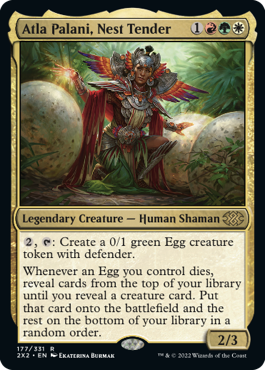
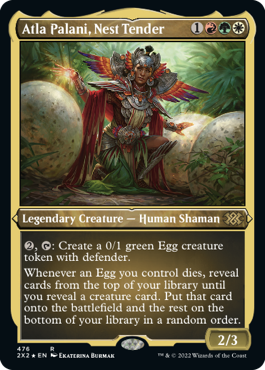
Next, is a popular land, first seen in the original Innistrad block.
-
Click here to see Cavern of Souls
-
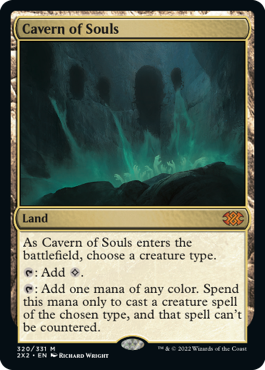

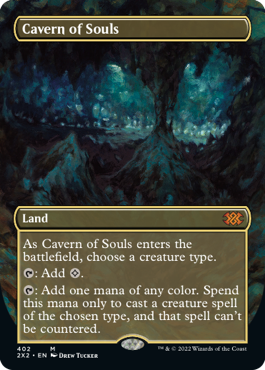
These reprints should demonstrate that the reprint choices were made with different formats in mind, including an extra eye toward Commander.
Double Time
I hope you all enjoyed today's story and previews. As always, I'm eager for any feedback, be it on today's article or on Double Masters 2022 itself. You can email me or contact me through any of my social media accounts (Twitter, Tumblr, Instagram, and TikTok).
Join me next week as I reminisce about how some of the cards in Double Masters 2022 came to be.
Until then, may this set double your enjoyment as you play it.
- Episode 938 Double-Faced Cards
- Episode 937 CLB Vision Design with Glenn Jones
- Episode 936 Fifth Dawn

